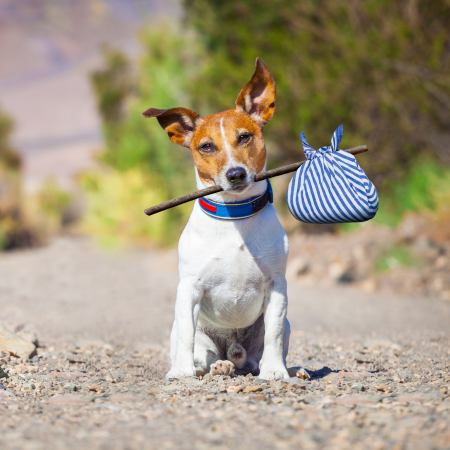 When you find a fur kid wandering the neighborhood, it can be a challenge sometimes to help them get home to their family. PetHub has put together a list of tips on what you should do if you find a dog who isn't where they should be.
When you find a fur kid wandering the neighborhood, it can be a challenge sometimes to help them get home to their family. PetHub has put together a list of tips on what you should do if you find a dog who isn't where they should be.
Every so often, you’ll be tempted by a furry creature that shows up at your back door, sniffing around for food, or a bedraggled pooch wandering around the neighborhood, looking a little lost and lonely. While there’s no doubt that the animal is in need of your love and attention, there are some things that need to be done before you fall in love with a furry friend who may just be looking for his family. Every year, millions of dogs end up displaced from their homes, and a majority of the time, there is an owner somewhere mourning the loss of a beloved friend.
While some of these dogs end up in unfortunate situations, confined to shelters, living life on the streets or in the woods as a stray dog, or even euthanized due to pet overpopulation concerns, some have a more positive end to their stories. Some end up being adopted from a humane society or shelter, but even more end up finding a loving home with the person or family that initially rescued them.
Although this may seem like the ideal, happily-ever-after situation for both a lost pet and his new owner, it’s important to remember that there’s someone else out there missing him, and possibly actively looking to be reunited with him. If, after a significant amount of time goes by, you cannot find the dog’s owner and wish to adopt him, it may bring him a second chance at a happy and beautiful life. However, before this point, it is imperative to actively search for the pooch’s home. Especially if the dog is hungry but doesn’t look as if he’s been out on the streets or living in the wild for too long, it’s important to think of him as a lost dog rather than a stray dog.

Every pet owner should invest in a heavy-duty collar and identification tags that will stand up to the test of time. When a dog comes barking at your door asking for help, food, or love, the first thing to do is to check to see if he’s wearing tags. The information on these tags may include the pet’s name, any medical conditions, the contact phone number or e-mail address of his owner, and any warnings as to his temperament. If a dog is xenophobic (afraid of strangers) or a breed known for aggressive tendencies, he may be wearing a tag warning prospective rescuers that he is not rabid or wild, but just afraid of those he does not know. It’s a better idea to gain his trust and confidence than to call animal control, which has a habit of euthanizing xenophobic dogs due to mistaking them as aggressive and a danger to others.
PetHub has a
unique tag that links to his pet profile page via a unique QR code imprinted on the tag. You can type in the code from any computer, or scan it with a compatible mobile device, and immediately pull up a profile that shows a picture of the pet and gives as much detail as the owner has seen fit to share. If the pet is missing, it will activate a lost pet alert, and share the owner’s contact details. In many cases, a single phone call is all it takes to reunite a pet and his owner.
If the dog is not wearing ID tags, the next step is to take him to the humane society or to your own veterinarian to have him scanned for a microchip. Because a microchip can only be read by a certain machine, you may not even know it’s there, but it is a convenient way to identify dogs, share their medical needs and histories, and reunite them with their owners.
If none of these get you any closer to finding the owner, and you’re willing to take the lost pooch in for a few days, you can take proactive steps such as
making up flyers with the dog’s photo, putting up posters announcing, “Dog Found," and calling the local humane societies on a daily basis. Many have an updated list of dogs that have been found, and anyone can call and listen to a list of animals that are in need of help finding their way home. Whether you decide to keep the dog, or to turn him over to a shelter or humane society, it’s important to get the dog listed on there.
If you do decide that adopting the dog is not for you, take care to leave him at a local no-kill shelter, rather than simply letting him run free or taking him to the closest humane society. Because of overpopulation, many dogs are put up for adoption if the owner hasn’t been located within 3 days and may be euthanized immediately if deemed not suitable for adoption due to age, temperament, or medical issues. Some shelters will not accept breeds such as Pit Bulls or Rottweilers, but there are rescue organizations dedicated to saving the lives of these often gentle creatures. Take the time to do research before deciding who is best suited to help your lost friend.
Should you decide to adopt, a trip to the veterinarian is one of the first orders of business. If the dog has not been properly identified or microchipped, it’s impossible to know his medical needs or history. A thorough examination, and a bit of paperwork, is necessary before making a lost pooch the newest member of your family.
 When you find a fur kid wandering the neighborhood, it can be a challenge sometimes to help them get home to their family. PetHub has put together a list of tips on what you should do if you find a dog who isn't where they should be.
When you find a fur kid wandering the neighborhood, it can be a challenge sometimes to help them get home to their family. PetHub has put together a list of tips on what you should do if you find a dog who isn't where they should be.



